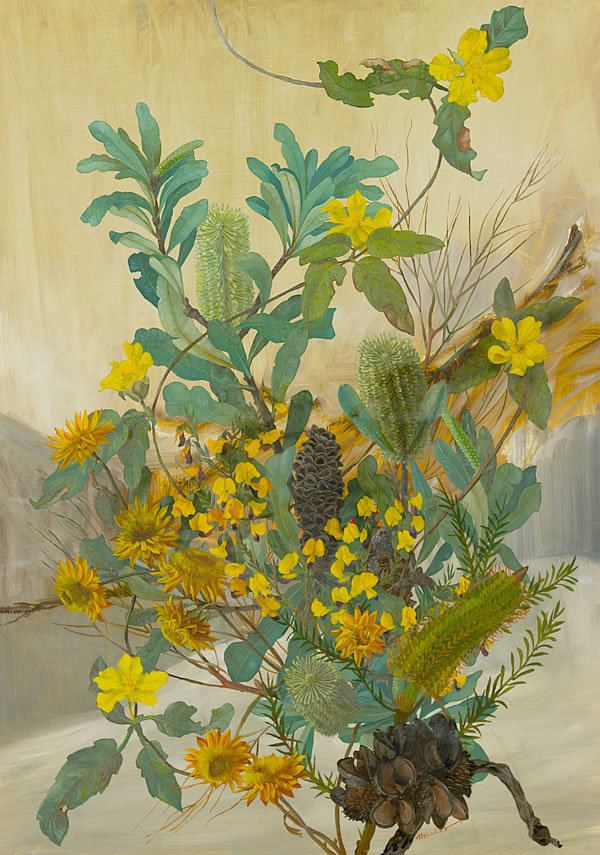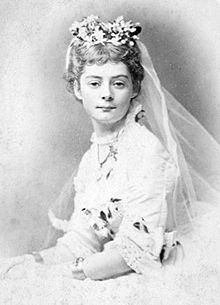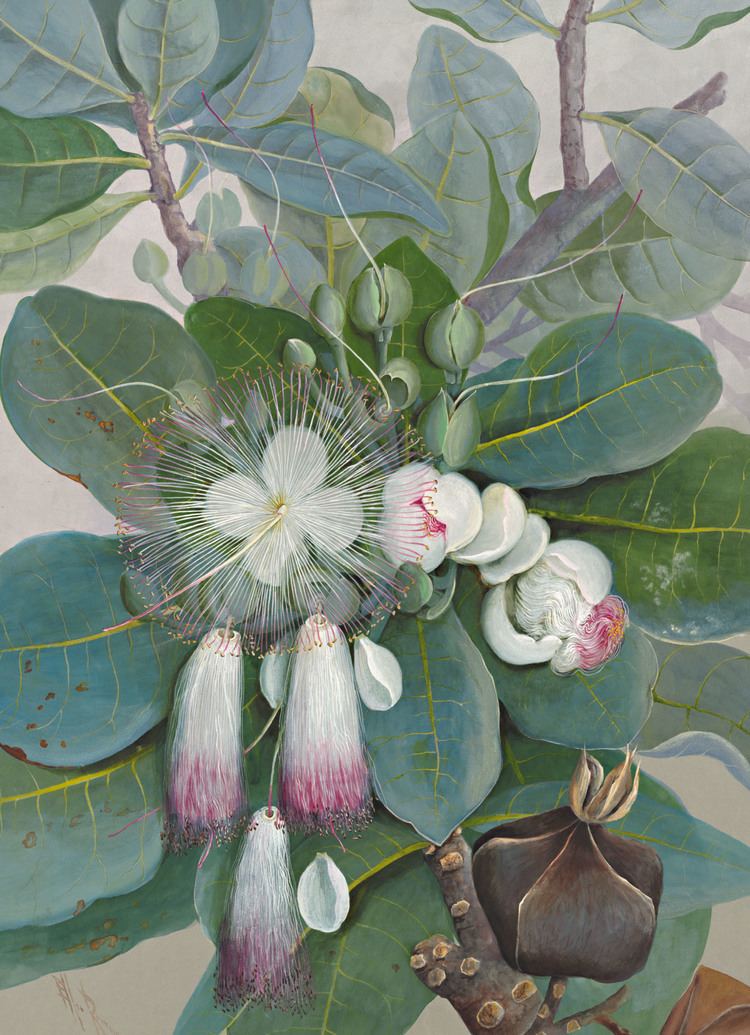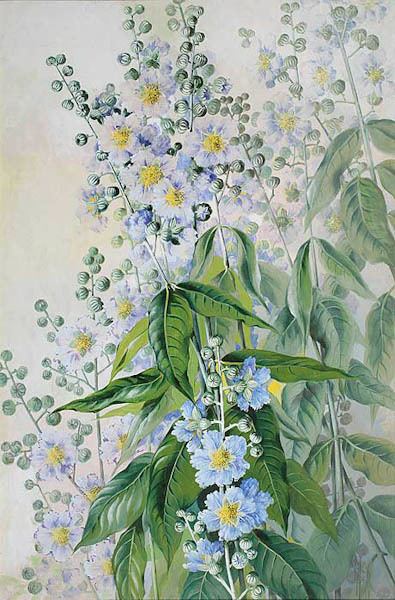Other names Marian Ellis Rowan Name Ellis Rowan | ||
 | ||
Full Name Marian Ellis Ryan Known for natural history illustration Books Flower Hunter, A festival of Ellis Rowan flower paintings Grandparents Susannah Cotton, John Cotton Similar People Paul Ryan, Chauncey Beadle, Janna Ryan | ||
Parents Marian Ryan, Charles Ryan | ||
Marian Ellis Rowan (30 July 1848 – 4 October 1922), known as Ellis Rowan, was a well-known Australian artist and botanical illustrator. She also did a series of illustrations on birds, butterflies and insects.
Contents

Life

Marian, the daughter of Marian and Charles Ryan, principal of stock agents Ryan and Hammond, was born at "Killeen" near Longwood, Victoria, one of her father's pastoral stations in Victoria. Her family was well-connected: sister Ada Mary married Admiral Lord Charles Scott, son of the Duke of Buccleuch; brother Sir Charles Ryan was a noted Melbourne surgeon and for a time Turkish consul in London (and whose daughter became Baroness Casey). Another niece was Joice NanKivell Loch.

She was educated at Miss Murphy's private school in Melbourne, and in 1873 married Captain Charles Rowan, who had fought in the New Zealand wars. Her husband was interested in botany and he encouraged her to paint wild flowers. She had had no training but working conscientiously and carefully in water-colour; her work is noted for being botanically informative as well as artistic. Rowan returned to Melbourne in 1877, and for many years travelled in Australia painting the flora of the country, at times in the company of her painting companion, Margaret Forrest. She published in 1898 A Flower-Hunter in Queensland and New Zealand, largely based on letters to her husband and friends.

About this time she went to North America and provided the illustrations, many in colour, to A Guide to the Wild Flowers, by Alice Lounsberry, published in New York in 1899 as well as Guide to the Trees (1900), and Southern Wild Flowers and Trees (1901) also by Lounsberry. It was while in America, travelling with Lounsberry, that Rowan received news that her son Russell (called "Puck") had been killed in the Second Boer War. In 1905 she held a successful exhibition in London. She returned to Australia and held exhibitions of her work which sold at comparatively high prices. In 1916 she made a trip to New Guinea, the first of several during which she produced a huge volume of illustrations. She contracted malaria during these journeys. In 1920 she held the largest solo exhibition seen in Australia at the time, when she exhibited 1000 of her works in Sydney. She died at Macedon, Victoria, her husband and her only son having predeceased her (her husband died in 1892, aged 47, possibly by suicide; and her son died of nephritis in Africa, aged 22, while in jail awaiting trial on charges of forgery).
Other books by Rowan published in Australia were Bill Baillie, his Life and Adventures, The Queensland Flora, and Sketches in Black and White in New Zealand.
Several accounts of her career have been published including:
In 1923, a year after her death, her surviving collection of 952 paintings was offered to the Australian government by her estate. The offer was debated in the House of Representatives. Parliament eventually agreed on a price of 5000 pounds for the paintings, half the asking price, and they became the property of the Australian Commonwealth. The collection was stored in the vaults of the Federal Treasury in Melbourne until 1933, when custody was transferred to the Commonwealth National Library. The paintings are now housed at the National Library of Australia. A further fifty-two paintings are held at the Queensland Museum. The Australian Club in Melbourne, one of that city's oldest and most venerable establishments, has a room with the walls entirely covered in murals by her, painted as a result of a commission from the Club.
Despite winning several gold medals judged by international artists against some of Australia's leading male artists, a distain for her ability, artistry, and capacity due to her gender resulted in a bias against her art that lasted decades. Her art was housed in the National Library, not the National Gallery. And to date, the major purchase by the Australian government has either been mostly hidden from public view, or her art was farmed out to overseas government offices.
Her portrait by Sir John Longstaff, paid for by public subscription, was unveiled in 1929. It was the first national portrait of an Australian woman.
Rowan Street in the Canberra suburb of Cook is named in her honour.
Queensland Museum Collection
The Queensland Museums collection of 125 botanical paintings by Ellis Rowan has been in accessible to the public for almost half a century. By 1912, her collection was taken from the old Town Hall to the Queensland Museum after Rowan's victorious Exhibition.
1. Painting techniques
Ellis Rowan painted most of her Queensland paintings indoor, she always worked into the night to drawn plants that she collected on her journey. On the other hand, Ellis was a rapid and direct painter who made her botanical paintings outdoor, which usually without the under-drawing of the pencil. She painted and traveled with her curiosity and personal interests, and she did not intend to be a serious botanical illustrator. She wrote of her Queensland Paintings:
'The collection is painted with a view of showing the general public how the flowers grow with their surroundings—while they are all botanically correct you cannot in the one drawing make a picture of the flower and also show it scientifically drawn in sections which is quite a different study.'
Ellis desired to make artistic compositions, which generally represented with bold close-up form. The colorful and vivid flora painted by her were not in the conventional way but placed in the varies native habitats, extending beyond the picture frame. It is said that her composition was influenced by the Thornton’s Temple of Flora. Ellis sometimes added insects and even snakes to her artworks, like some of Thornton’s artists, in order to achieve the dramatic effect.
Claiming herself a self-taught painter, Ellis combined traditional watercolor techniques with opaque paints that she used to illustrate detail. She produced multiple copies of her paintings, and this non-professional and peculiar practice resulted in the difficulty of classifying the quantity of her output.
2. Plants
For today's botanists, Ellis Rowan’s painting has limited scientific research value because they are lacking the critical details that is necessary for the botanical illustrations. However, these flora drawings are accurate and clear enough to help people identify most of the plants she drew. Although Ellis confessed that she knew very little about plants, she maintained her passion and love to discovering the botanical world, dried many specimens as her collections.
In the early year of her career, there was the trend that depicting the flower or fruit as an isolated part or branch, but her later career showed a change which was inclined to put plants in their own environment rather than in a studio-like space. Ellis created her botanical world more than paint every detail of her observation. There are some ‘new species’ plants created by Ellis, which often added one part of a plant to another, the most surprisingly, the arrangement of these different types plants presented a pleasing combination.
There is another reason why Ellis’ paintings are not strong enough to be called the scientific illustration. It seems that Ellis had her own taste when she choosing the object, which resulted in the limitation of botanical species in her painting. She preferred colorful and showy species rather than many small-flowered herbaceous species, for example, waterlilies were her most favorite flowers, and there was no depicting of the large and significant sunflower family in her artworks.
3. Animals
In spite of the spectacular botanical paintings, Ellis Rowan is also good at depicting animals and insects. The series about New Guinea bird and butterfly drawings are her major exploration into animal paintings. One-third of Ellis’ paintings which collected in the Queensland Museum were illustrated plenty of species of animal, such as beetles, butterflies, snakes and dragonflies. These insects or animals in Ellis’ works probably added later after the plants, because most of Ellis paintings finished indoor and the flower was often picked by herself or given to her by the local people. it has been questioned that whether the representation of these real species was accurate in their context. It is probably that Ellis combined plants and insects at random, without thinking carefully about the relationship between them. Ellis’ interest with animals was derived from her early experience with her family, as recollected by her niece Lady Casey:
‘She had inherited the interest of her grandfather John Cotton not only in flora and fauna but in insects and even reptiles; she enjoyed the accident of life, the fusion of one aspect of nature with another. … Some of our family, the Le Souefs, actually had a feeling for shakes. They liked running their warm fingers over those long cold exquisite bodies.’
Ellis Rowan full of enthusiasm with her artistic creation, which enabled herself to observe the insect world and animal life. These magical creatures brought her entertainment and helped her escaped from her busy business of botanical painting. In spite of observing insects, Ellis also a collector of them. Her letters which wrote during her journey always mentioned collecting activities, and some of them were the adventurous stories of snakes. There were sheets of paper painted with rows and rows butterflies leaning on Ellis’ studio wall. They indicate the study that Ellis down as a source of adding to the flower paintings. However, the adding of these animals and insects were more for the artistic effect rather than the realistic illustration. Though the scientific value of Ellis’ botanical Paintings is limited, they are as the excellent record of history of some Queensland’s flora drawn by an artist who was in search of the aesthetic expression and picturesque beauty.
